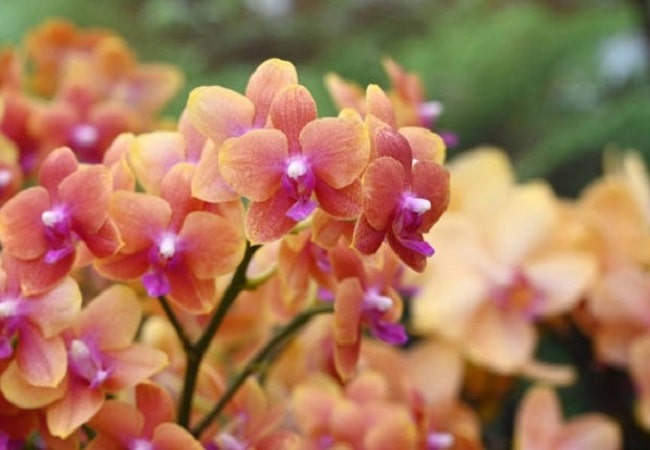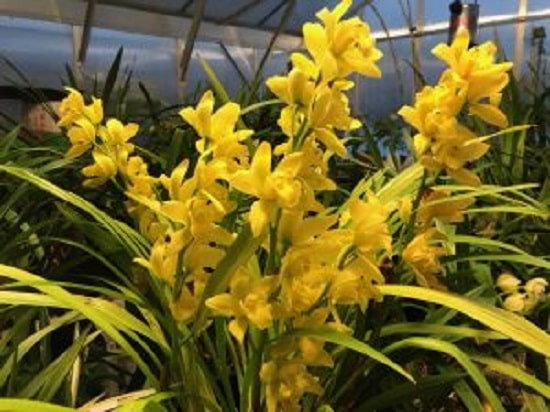Cymbidium orchids are a type of orchid that grows in Asia and Australia. They are also called “boat orchids.” People know them for their large, showy flowers that last a long time.
Cymbidium orchids are a popular type of orchid among people who like flowers. They are known for their pretty flowers, which come in different colors and sizes.
If you want to grow cymbidium orchids, what kinds of cymbidium orchids are there? In this blog post, I’ll discuss the different types of cymbidium orchids and how to care for them. Read on, and you’ll find out!
Quick Navigation
10 Types Of Cymbidium Orchids

Cymbidium orchids are a type of orchid with large, showy flowers that last long. They are native to tropical and subtropical parts of Asia, and orchid lovers and gardeners worldwide like to grow them. There are more than 50 species of Cymbidium orchids, and they come in many different sizes, colors, and shapes. Here are ten different kinds of Cymbidium orchids:
- Cymbidium Dayanum: This type of cymbidium orchid comes from China. It’s known for its small, fragrant, pink, red, and white flowers. In the spring, flowers grow in big groups, and In the spring, flowers grow in big groups and bloom.
- Cymbidium Madidum: This type of cymbidium orchid, called Cymbidium Madidum, is native to Southeast Asia. It is known for its large, colorful flowers in yellow, orange, and red. Most of the time, the flowers smell nice and have a wavy, ruffled look.
- Cymbidium Goeringii: This kind of cymbidium orchid is native to China. It is known for its tiny yellow flowers that smell sweet and light. The flowers grow in big groups and bloom in the spring.
- Cymbidium Sanderae: This type of cymbidium orchid is native to Southeast Asia. It is known for its small, fragrant flowers in shades of pink, red, and white. The flowers grow in big groups and bloom in the fall.
- Cymbidium Canaliculatum: This cymbidium orchid is endemic to Southeast Asia. Its tiny, fragrant blossoms are pink, crimson, and white. In September, large groupings of flowers bloom.
- Cymbidium Floribundum: Cymbidium floribundum is an orchid native to Southeast Asia. It has small, fragrant flowers that can be white, pink, or red. It is known for being able to grow in many different climates, and it is often used to make new kinds of plants.
- Cymbidium Erythrostylum: This orchid is from Southeast Asia and has small, fragrant flowers that are white, pink, or red. It is known for being able to grow in many different climates, and it is often used to make new kinds of plants.
- Cymbidium Ensifolium: This small to a medium-sized orchid is native to China, Japan, and Southeast Asia. It has long, skinny leaves and clusters of small, fragrant yellow, green, or brown flowers.
- Cymbidium sinense: This Chinese orchid features tiny, fragrant yellow, green, or brown blooms. It thrives in moderate settings and is used to create new plants.
- Cymbidium eburneum: This orchid comes from China and has big, waxy flowers that are white, cream, or yellow. It is known for having flowers that last for up to eight weeks.
Cymbidium Orchid Varieties

Cymbidium orchids are a popular and diverse group of orchids that come in various colors, sizes, and shapes. Some popular varieties of cymbidium orchids include:
Pink Cymbidium Orchid Plant
Large, pink blossoms characterize this cultivar. They’re popular with beginner and professional gardeners since they’re simple to cultivate and maintain.
To care for a pink cymbidium orchid, give it a well-draining soil mix and bright, indirect light. To avoid overwatering, water the plant frequently. Feed the blossoming plant a balanced fertilizer heavy in phosphorus. Avoid drafts and extreme temperatures to help the plant flourish.
Green Cymbidium Orchid Plant
Its brilliant green blooms and leaves make it a standout in any garden. Like other cymbidium orchids, it prefers indirect sunlight and well-drained soil.
To avoid overwatering, water the plant often but let the soil dry. When blossoming, feed the plant a balanced, phosphorus-rich fertilizer. To promote growth, avoid drafts and extreme temperatures.
Yellow Cymbidium Orchid Plant
This type has large, showy flowers that are usually yellow. It can grow in many climates and isn’t too hard to take care of, so both experienced and new gardeners like to use it.
To take care of a yellow cymbidium orchid, ensure it has the right growing conditions, such as a soil mix that drains well and a place that gets bright, indirect light. Water the plant often, but let the soil dry out a little between waterings to keep it from getting too much water. Feed the plant regularly with a balanced fertilizer high in phosphorus when it is blooming. Keep the plant away from drafts and temperatures that are too high or too low to help it grow.
Light Pink Cymbidium Orchid Plant
This type has large, showy flowers that are a light pink color. It can grow in various climates and isn’t too hard to take care of, so both experienced and new gardeners like to use it.
To take care of a light pink cymbidium orchid, give it the right growing conditions, such as a soil mix that drains well and a place with bright, indirect light. Water the plant often, but let the soil dry out between waterings to keep it from getting too much water. Feed the plant regularly with a balanced fertilizer high in phosphorus when it is blooming. Help the plant grow by keeping it away from extreme temperatures and drafts.
Cymbidium Golden Elf Orchid Plant

This is a miniature cymbidium orchid variety with small yellow flowers and bright green foliage. It is well-suited to growing in pots and is famous as a houseplant.
To care for a Cymbidium Golden Elf orchid, provide the right growing conditions, including a well-draining soil mix and a location with bright, indirect light. Water the plant periodically, but let the soil dry out between waterings to avoid overwatering. Fertilize the plant regularly, using balanced fertilization high in phosphorus during the blooming season. Protect the plant from extreme temperatures and drafts to help it thrive.
Charlie Brown Cymbidium Orchid Plant
This cymbidium orchid grows well in low temperatures and blooms with tiny, brownish-purple petals. It thrives in the lower temperatures of its native highlands and can survive down to -40 degrees Fahrenheit.
Give your Charlie Brown cymbidium orchid well-draining soil and bright, indirect light. To prevent overwatering, water the plant frequently but let the soil dry out slightly in between waterings. Use a balanced fertilizer heavy in phosphorus once a week during the plant’s flowering period. Keep the plant out of the cold and the draft to promote its growth.
Large Cymbidium Orchid Plant
This is a standard cymbidium orchid variety with large, showy flowers in various colors, including white, yellow, pink, red, and purple. It’s popular with novice and professional gardeners since it’s simple to cultivate and maintain.
Give large cymbidium orchids well-draining soil and bright, indirect light. Water the plant occasionally but allow the soil to dry out to prevent overwatering. Use balanced phosphorus-rich fertilizer during blooming. Avoid extreme temperatures and drafts for plant growth.
Most Commonly Asked Questions
What Is The Best Orchid For Growing In The Home?
There are many different kinds of orchids that you can grow at home. What you like and how and where you grow plants will determine your best choice. Here are some varieties of orchids that grow well at home:
- Phalaenopsis orchids: These easy-to-grow orchids have long-lasting blooms and are famous for home cultivation. Bright, indirect light suits them. Let the soil dry out between waterings.
- Paphiopedilum orchids: Tropical “lady’s slipper orchids” thrive inside. They like intense, indirect light. Watering regularly but letting the soil dry out between waterings might help.
- Cattleya orchids: Cattleya orchids have enormous, beautiful blossoms. Gardeners of all levels like them. Bright, indirect light suits them. Between waterings, let the soil dry out.
- Cymbidium orchids: These “boat orchids” are popular with experienced and novice gardeners. They like intense, indirect light. Watering often might help, but allow the soil to dry out between waterings.
How Much Do Cymbidium Orchids Cost?
Cymbidium orchid prices depend on size, variety, and location. Cymbidium orchids cost $20–100.
Larger or rarer cymbidium orchids may cost more. If the plant is blooming, the price may change. Specialty nurseries and florists may charge more for orchids than garden centers or internet retailers.
Cymbidium orchid prices vary by plant and location. Always compare rates and shop around to obtain the most excellent bargain.
How Do I Identify A Cymbidium Orchid?
Look for these signs to identify an orchid:
- Size: Cymbidium orchids have long, thin leaves and tall bloom stalks.
- Flower shape: Cymbidium orchids feature trumpet-shaped, enormous blooms. Flowers are white, yellow, pink, crimson, or purple.
- Lip shape: Cymbidium orchids are called “boat orchids” because their lips are boat-shaped.
- Leaf shape: Cymbidium orchids feature tall, slender, glossy, leathery leaves.
These traits help identify cymbidium orchids. To confirm plant identification, consult a trusted source or expert.
What’s the best potting mix for Cymbidium orchids?
Cymbidium orchids are like a well-drained potting mix. Cymbidium orchid potting mix should contain moisture and nutrients yet drain excess water. Cymbidium orchid potting mixes include:
- Orchid bark mix: Cymbidium orchids like orchid bark mix because it drains and breathes. Acceptable to coarse orchid bark mix is created from bark particles.
- Coir: Coconut husks make coir, an organic potting mix—Cymbidium orchids like its moisture retention and slightly acidic pH.
- Perlite and peat moss: A lightweight, porous volcanic rock and degraded organic matter, respectively. Cymbidium orchids benefit from their drainage and airflow.
- Sphagnum moss: Cymbidium orchids are typically potted in sphagnum moss. Its slightly acidic pH and moisture retention make it an ideal option.
No matter which potting mix you choose, you’ll need to give your cymbidium orchid the proper care and growing conditions for it to do well. This means giving it bright, indirect light, watering it often, and fertilizer often.
Final Word
Cymbidium orchids are very popular in the flower business because they are so pretty and come in many different colors and shapes. There are many cymbidiums so that you can choose the right size, shape, and color for your garden or flower arrangement. All cymbidiums need filtered light, soil with good drainage, and regular watering. With the proper care, these beautiful flowers can last for years in your home or office.

I’m Md. Mahfuz Anam always enjoys taking care of plants and gardening. I find it therapeutic and a great way to relax. I have also always been interested in learning about different types of plants and how to care for them.


